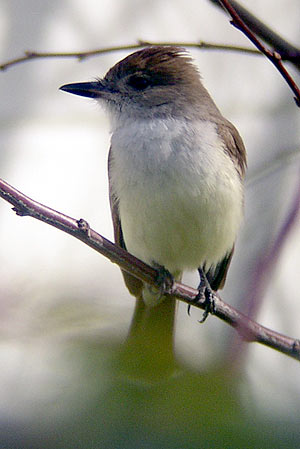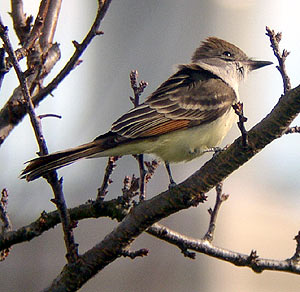
Myiarchus Flycatcher (Originally identified as Nutting's Flycatcher, I now believe it to
be an Ash-throated Flycatcher; see below)
Santa Cruz, Santa Cruz County, California
3 January 2003
Joseph Morlan
 Last night I received
word from David Suddjian that a questionable Myiarchus had been seen on private property in Santa Cruz.
Originally found by Michelle Scott on 1 January 2002, it was studied 2 January by Steve Gerow who found a number
of discrepancies between it and the expected Dusky-capped Flycatcher. These discrepancies suggested the bird might
be a Nutting's Flycatcher. David arranged for Dan Singer, Don Roberson, Rita Carratello, Robbie Fischer and me
to visit the private residence today. There we met Steve Gerow and David Suddjian. Soon Steve found the bird and
we had brief looks as it foraged in an olive tree. Later it landed on the ground in the front yard of a house where
it ate a fallen olive. Much of the time, the bird called, a sharp "qwip" repeatedly.
Last night I received
word from David Suddjian that a questionable Myiarchus had been seen on private property in Santa Cruz.
Originally found by Michelle Scott on 1 January 2002, it was studied 2 January by Steve Gerow who found a number
of discrepancies between it and the expected Dusky-capped Flycatcher. These discrepancies suggested the bird might
be a Nutting's Flycatcher. David arranged for Dan Singer, Don Roberson, Rita Carratello, Robbie Fischer and me
to visit the private residence today. There we met Steve Gerow and David Suddjian. Soon Steve found the bird and
we had brief looks as it foraged in an olive tree. Later it landed on the ground in the front yard of a house where
it ate a fallen olive. Much of the time, the bird called, a sharp "qwip" repeatedly.
At this point I was convinced that the bird was not a Dusky-capped Flycatcher. It seemed a bit too large, its
bill was too stout, and it's call was all wrong. I considered Great Crested Flycatcher, but the chest was much
too pale and there was not enough red in the tail. Brown-crested Flycatcher looks somewhat similar and may have
a similar call-note, but our bird showed little reddish under the tail, and other observers had seen yellowish
in the secondaries which is better for Nutting's. Ash-throated Flycatcher has more red under the tail, and has
pink rather than the orange mouth lining that Steve Gerow had seen on this bird. Unfortunately the bird did not
stay around long enough for me to confirm all the features I wanted to see for such an unprecedented record.
Don Roberson and Rita Carratello arrived shortly after the bird disappeared, and we waited about two and a half hours before the bird showed up again, shortly after noon. This time the bird flew to low shrubs across the street and afforded excellent views. I took the digiscope images you see here and Dan and Don took photos with conventional film cameras while Rita took video. Dan also attempted to record the bird's vocalizations with a tape recorder. With these better views, we were able to confirm the identification as Nutting's Flycatcher. The bird showed all the known characters of this somewhat enigmatic species, which has been recorded in California only once before.
We then met with Rick Linzer, the owner of the house with the olive trees and he graciously gave permission for birders to view the bird from the street. Please do not enter the private residence. The bird can be seen best from the street.
The following description is based on notes made while watching the bird:
A medium sized Myiarchus, about the size of Ash-throated Flycatcher. The crest was decidedly brownish. The face was brownish blending to a pale gray breast. The lower breast and belly were light yellow. The back was brown with a slight olive cast in some light conditions, but I believe this was mostly the greenish light from the leaves. When perched in the open, no olive coloration was visible. The uppertail coverts were a warmer rusty brown color.
The primaries were edged rusty, the tertials were narrowly edged whitish, and the secondaries were edged grayish-white distally, but yellowish basally. The yellowish fringes at the bases of the secondaries were not always visible when the wing was folded. The primary projection seemed quite short. The tips to the wing coverts were edged broadly with grayish white, forming two distinct wing-bars. The median coverts were more broadly and distinctly fringed than the greater coverts. This made the upper wing-bar appear stronger and more distinct than the lower wing-bar.
The tail was dusky-brown above, grayish below with a diffuse pattern of rusty on the inner webs of the rectrices. This reddish color extended all the way to the tip of the tail on most of the central rectrices, but only barely reached the tip of the tail on the outermost pair of rectrices.
The bill was dark and quite stout at the base. The base of the lower mandible was pinkish. As the bird was consuming an olive, the mouth lining could be seen as orange. The legs and feet were black.
The call was a sharp "pweeep" very different from any vocalization of Dusky-capped Flycatcher, but recalling a quiet Brown-crested Flycatcher.
The bird was quite active, often foraging close to the ground. It frequently raised its crest and cocked its head from side to side. It fed entirely on olives during the time I had it under observation. At no time did I see it eat insects. This fruit-eating is similar to the behavior of the Nutting's Flycatcher which wintered in Orange County two years ago.
Discussion
Additional description and analysis by Don Roberson and video-capture photos by Rita Carratello have been posted here.
[Edited September 16, 2003] The above is unedited from my original. However, analysis of vocalizations show this bird was actually an Ash-throated Flycatcher (see below).
Acknowledgments
Special thanks go to Rick Linzer, Michelle Scott, and David Suddjian for facilitating access, and Steve Gerow for his keen observations which led to this unexpected identification.
Updates
Online References
Dittmann, D.L. & Cardiff, S.W. 2000. Let's take another look: Myiarchus flycatchers. LOS NEWS/NO. 193 - DECEMBER 2000 - PAGE 3
Lanyon, W. E. 1961. Specific limits and distribution of Ash-throated and Nutting flycatchers. Condor 63: 421-449.